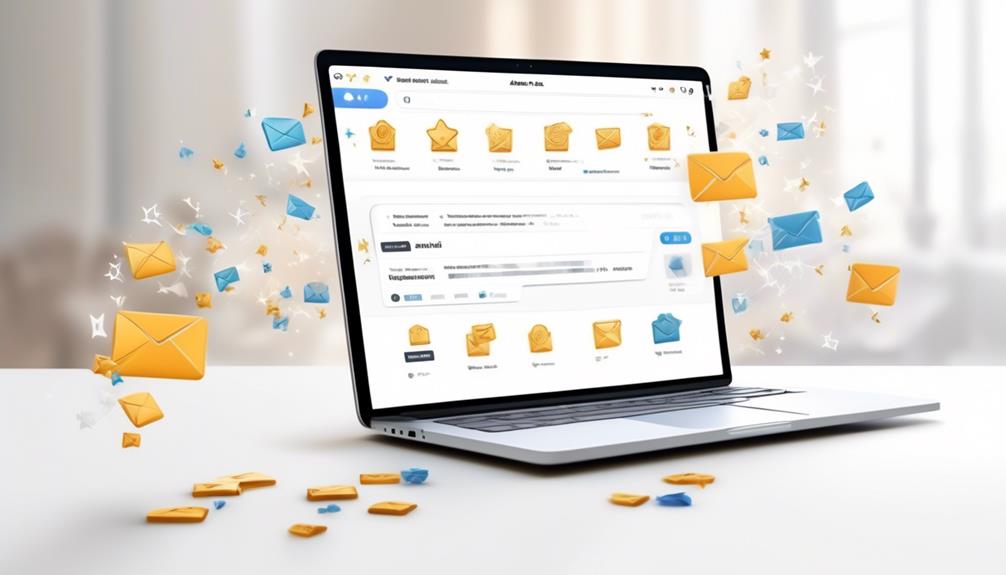So, you’ve successfully set up your new email account and are all set to take on the digital realm. However, pause for a moment – have you taken the time to warm it up? It might come as a surprise to find out that preparing an email account for use involves more than merely pressing send.
It's a strategic process that can significantly impact your email deliverability and engagement rates. But what exactly does it mean to warm up an email, and why should you care?
Well, let's just say there's more to it than meets the eye, and it could make all the difference in how your emails are received.
Key Takeaways
- Gradually increasing sending volume and using authentication methods such as SPF, DKIM, and DMARC are important steps in email warm-up.
- Switching to a dedicated IP address and employing a custom domain can enhance authenticity and trustworthiness.
- Email warm-up helps improve sender reputation, email deliverability, and decreases the chances of emails being filtered as spam.
- Regular engagement, manual sending of cold emails, and following best practices are effective strategies for successful email warm-up.
Understanding Email Warm-Up
We kicked off our email warm-up process by gradually increasing the sending volume of our new or inactive email account to enhance its reputation. This step was crucial in ensuring that our emails weren't classified as spam by our email service provider (ESP) and that our domain's reputation remained intact.
Understanding the importance of warming up an email account, we implemented best practices such as using SPF, DKIM, and DMARC methods for authentication, switching to a dedicated IP address, and employing a custom domain for authenticity.
As we delved into the process, we realized that email warm-up isn't just about increasing sending volume but also about building a positive history and reputation with ESPs and ISPs. We learned that this process typically takes 8 to 12 weeks to reach maximum deliverability potential and should be maintained to sustain a high email reputation.
Embracing these techniques not only improved our email deliverability but also enhanced the content of our emails, ensuring that they were personalized and free from spam-triggering words.
Importance of Email Warm-Up

Enhancing the deliverability and trustworthiness of an email account through the process of warm-up is essential for ensuring safe and effective engagement with email campaigns. When starting with a new email address or sending cold emails from an inactive account, the reputation of the email account is crucial. Therefore, warm up your email to improve your sender reputation and email deliverability. Neglecting the warm-up process can significantly decrease the chances of your emails reaching the intended recipients' inboxes. A poor email reputation can lead to emails being filtered as spam, resulting in missed opportunities for communication and engagement with your audience.
Improving your email account's reputation through warm-up can significantly increase the chances of your emails being delivered to the primary inbox, rather than being diverted to spam folders. It also helps in building trust with internet service providers and email clients, which in turn enhances the overall effectiveness of your email marketing efforts.
Best Practices for Email Warm-Up
Let's talk about the best practices for warming up an email account.
We'll cover the basics of email warming, the importance of a gradual warm-up process, and effective strategies to achieve optimal deliverability.
These practices are crucial for building a positive email reputation and ensuring that your emails reach the intended recipients.
Email Warming Basics
When warming up an email account, it's crucial to adhere to best practices for optimal deliverability and engagement.
To start, it's essential to gradually warm up the new or inactive email by slowly increasing the volume of sent emails. This process typically takes 8 to 12 weeks to reach maximum potential, requiring continuous maintenance.
Using a dedicated IP address and authenticating the account with SPF and DKIM records are crucial steps in email warming.
Additionally, utilizing a custom domain and improving email content can make a significant difference in the warming process.
Importance of Warm-Up
Gradually increasing the volume of sent emails is crucial for warming up an email account and improving its reputation and deliverability. Warming up your email is essential to ensure a good reputation with email service providers (ESPs) and internet service providers (ISPs), leading to a higher delivery rate.
Starting with a low volume and gradually ramping up over time is key to building trust and credibility. Utilizing a dedicated IP address, along with an email warm-up tool, can significantly improve the reputation of your IP address.
This process also helps to establish a positive sending history, which is vital for achieving better deliverability and inbox placement. By following best practices for email warm-up, you can enhance your email marketing efforts and maximize the effectiveness of your campaigns.
Strategies for Warm-Up
Successfully warming up an email account involves implementing strategic best practices to enhance its reputation and deliverability.
To begin, it's crucial to start with a low volume of emails and gradually increase the sending quota. Engaging in regular activities such as replying to emails, marking them as important, and gradually increasing the volume will signal to email service providers that the account is legitimate.
Additionally, sending cold emails manually instead of using automated tools can also contribute to a successful warm-up process. New email accounts should focus on warming up the IP address by sending emails to engaged recipients and progressively including cold emails in the mix.
Manual Email Warm-Up Methods

When it comes to manual email warm-up methods, we've found that focusing on effective warming techniques and engaging email tactics can make a big difference.
By gradually increasing the number of emails sent each day and actively participating in email conversations, we can improve our email account's reputation and deliverability.
It's important to follow best practices, such as using a custom domain and avoiding spammy words, to ensure a safe and successful warm-up process.
Effective Manual Warming
After comprehensively establishing the significance of manual email warm-up, let's delve into effective methods for building and maintaining a strong email reputation.
- Gradually Increase Sending Volume: Start by sending a small number of personalized emails daily and gradually increase the volume over time to avoid triggering spam filters and hitting daily sending limits.
- Engage in Authentic Email Activities: Actively participate in email conversations, mark important emails, and subscribe to newsletters to warm up the inbox and enhance the sender's reputation.
- Authenticate Your Account: Use SPF, DKIM, and DMARC methods to authenticate your IP address and domain, ensuring better deliverability and trust from email service providers.
- Avoid Spam Triggers: Craft personalized subject lines, optimize preheaders, create readable copies, and avoid spammy words to prevent your emails from being flagged as spam.
Email Engagement Tactics
As we focus on Email Engagement Tactics for manual email warm-up, we continue to emphasize the importance of gradually increasing sending volume and engaging in authentic email activities to maintain a strong email reputation. To effectively warm up an email, it's crucial to employ email engagement tactics that improve the open rate and build a positive reputation. This involves sending individual emails with personalized subjects, subscribing to newsletters, replying to emails, and marking them as important. Below is a table summarizing key email engagement tactics:
| Email Engagement Tactics | Description | Purpose |
|---|---|---|
| Personalized Subjects | Tailoring subjects to recipients | Improve open rates |
| Genuine Responses | Replying and marking as important | Simulate authentic engagement |
| Newsletter Subscriptions | Subscribing to relevant newsletters | Mimic genuine interest in content |
Automated Email Warm-Up Tools

Automated Email Warm-Up Tools streamline the process of gradually increasing email sending volume, thereby establishing a positive sender reputation. These tools simulate real user behavior and gradually increase email volume to improve deliverability.
The email warm-up process starts by sending a test and gradually increasing the number of warm-up emails. This approach aids in maintaining consistent engagement and building a good reputation with email service providers and ISPs.
Using automated email warm-up tools is essential when sending cold emails or trying to warm up your inbox to ensure safe delivery and maximum open rates for email campaigns. It saves time and effort, making it a recommended choice for efficient and effective email warm-up results.
- Simulate real user behavior
- Gradually increase email volume
- Maintain consistent engagement
- Build a good reputation with email service providers and ISPs
Signs to Stop Email Warm-Up

As we monitor the signs to stop email warm-up, we recognize the importance of maintaining consistent engagement and sender reputation established through the automated warm-up process. When assessing the need to conclude the warm-up period, certain indicators can help determine if the email account has been sufficiently warmed up. Here's a quick reference table to help identify these signs:
| Signs to Stop Email Warm-Up |
|---|
| High open rates and engagement |
| Low bounce rates |
| Desirable sender reputation |
| Low spam complaint rate (<0.1%) |
| Consistent delivery to inboxes |
Monitoring these signs ensures that the warm-up process aligns with the expectations of email service providers and safeguards the IP reputation. Once these indicators are met, it may be time to transition from the warm-up phase to regular email sending. By paying attention to these signals, we can ensure that the email account is perceived as a real human sender, not engaged in sending cold emails, and is compliant with the Google Spam update. This also helps in managing the volume of emails and maintaining a positive inbox placement.
Frequently Asked Questions
How Do You Warm up an Email?
We warm up an email by gradually increasing the sending capacity and reputation of a new or inactive account. This involves replying to emails, marking them as important, and gradually increasing the number of emails sent each day.
It typically takes 8 to 12 weeks to reach maximum deliverability potential and requires consistent effort to maintain a high email reputation. The process is crucial for improving email deliverability and establishing trustworthiness with ESPs and ISPs.
How Long Does It Take to Warm up Emails?
It usually takes about 8 to 12 weeks for emails to reach their maximum deliverability potential.
During this time, we gradually increase the number of emails sent each day and engage in activities like replying to emails and marking them as important.
This process helps prevent our emails from being blocked by spam filters and increases engagement with our content.
Plus, we follow best practices like using proper authentication methods and personalized subject lines to improve our email deliverability.
How Do I Know My Email Is Warmed Up?
We can tell our email is warmed up when we see:
- Improved deliverability
- Higher open rates
- Increased sending limits
Additionally, our emails are less likely to be blocked by spam filters, and our sender reputation with ESPs and ISPs is better.
It's essential to keep an eye on these metrics and maintain ongoing warm-up activities to sustain a high email reputation.
Why Is Email Warmup Important?
Email warm-up is crucial because it helps us establish a positive reputation and deliver our messages to recipients' inboxes. It's like building trust with email service providers and internet service providers.
Without warm-up, our emails might end up in spam folders or be blocked altogether. This process boosts our email deliverability, increases sending limits, and enhances our domain reputation.
It's an essential step in ensuring our messages reach their intended audience.
Can You Explain the Importance of Warming up an Email and How to Do It Effectively?
Email warming techniques are crucial for successful outreach. By gradually increasing the sending volume and engagement with the recipients, you can build trust with email providers. Start with a small number of emails and gradually increase. Monitor engagement metrics and adjust accordingly to ensure effective email warming.
What is the significance of warming up a Google email account?
The google email warming process is crucial for establishing the reputation of a new email account. Warming up the account by gradually increasing sending volume and building engagement helps to avoid being flagged as spam. This significantly impacts the deliverability and success of email marketing campaigns.
Conclusion
In conclusion, warming up an email is like training for a marathon – it takes time, effort, and consistency to reach peak performance.
By gradually increasing email activity and reputation, we can ensure that our messages reach their intended recipients' inboxes.
Remember, just like a good workout, proper email warm-up can lead to improved results and better engagement.
So, let's lace up our email shoes and start warming up for success!










